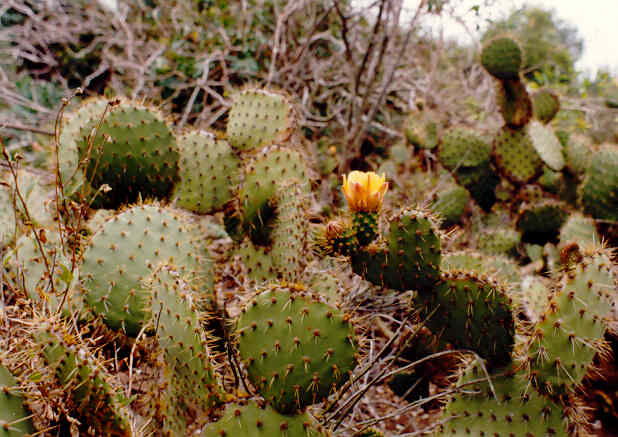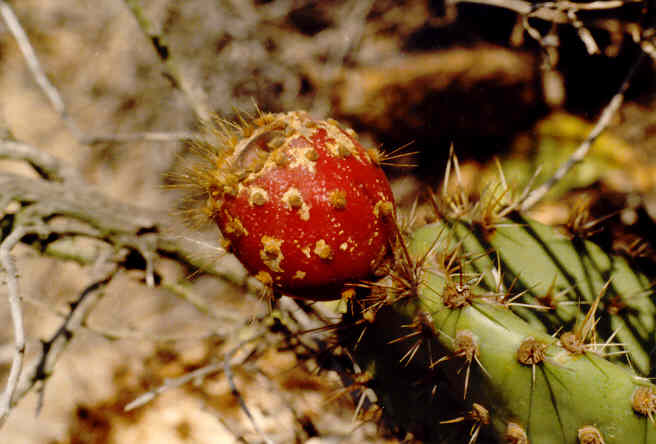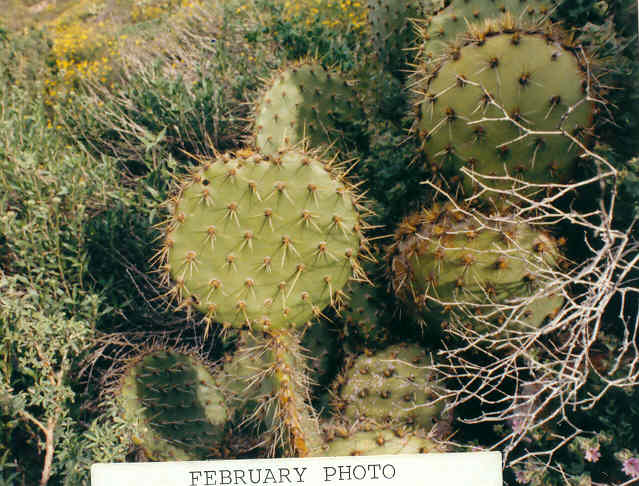
Opuntia
oricola Philbr.
Cactaceae
Cactus Family
Native
Oracle Cactus
 |
Opuntia
oricola Philbr.
CactaceaeCactus FamilyNative
Oracle Cactus
|
June Photo
Plant Characteristics:
Treelike with a trunk to ca. 3 dm. high, or more shrubby, whole plant 1-3
m. tall; joints green +/- rounded or broad, 1.5-2 dm. long; spines dense on the
joint, yellow and at first translucent, darker in age, mostly 8-16 per areole,
spreading, the lower ones larger and +/- curved
or twisted; inner perianth yellow, filaments orange-yellow; style red, stigma
green; fr. 3.7-6 cm., juicy, spheric; exterior purple-red; interior
white-yellow; seed-pulp generally red; areoles 23-63.
Habitat:
Sandy places below 500 ft.; Coastal Sage Scrub and V. Grassland; Santa
Barbara to n. L. Calif., extending inland to Santa Ana Canyon in Orange Co.
Channel Islands. April-May.
Name:
Opuntia, old Latin name used by
Pliny, formerly belonging to some other plant.
Munz, (Flora So. Calif. 314).
N.L. opuntia,
name of a cactus, said to be derived from Gr. opous, genit. Opountos, a
town in Greece, where a cactus-like plant "herba Opuntia" grew. (Jaeger 176). I am unable to figure out the species name opuntia from Jaeger.
Latin, ora, margin of land along
the coast, or sea coast, or shore, or bank of a river.
Latin, colo, to inhabit, to
live in. Oricola,
living or inhabiting the land along the coast. (John Johnson).
As a confirmation of this difficult word, the same definition of oricola
comes from Roland Brown's book Composition
of Scientific Words except that the Latin cola
is listed rather than colo; both are
defined as dweller or inhabitant. (my
comments).
General:
The frequency of this plant is not known as it resembles the very common O.
littoralis. Without careful scrutiny the two species are hard to tell
apart, particularly from a distance. Photographed
in Big Canyon. (my comments).
O. oricola, first described in 1964, has long been confused with O.
littoralis, which has virtually the same range.
O. oricola is
usually of erect rather than spreading habit; mature plants are often 6 feet or
more tall. The pads are almost
circular in outline rather than oblong-elliptical as in O.
littoralis. Rather than bone
white, the spines are clear, translucent yellow in unweathered condition.
Flowers are yellow as in O.
littoralis. The fruits tend to be globular rather than elongate, and lack
the narrowed base of O. littoralis.
Although some of the spines are straight, and occasionally all may be
nearly straight, the heavier spines are often characterized by a prominent
downward curvature. These large
plants can usually be spotted in colonies of coastal prickly pears by their
round pads. (Dawson 38).
Probably ca. 300 spp., from s. Canada to Straights of Magellan.
(Munz, Flora So. Calif. 314).
O. x demissa could be a hybrid
with this species as one parent. (Hickman,
Ed. 455).
Text Ref:
Hickman, Ed. 455; Munz, Flora So. Calif. 318; Roberts 17.
Photo Ref:
Feb-Mar 88 # 10,11; Nov-Dec 89 # 13; June 90 # 21A.
Identity: by R. De Ruff, confirmed by F. Roberts.
First Found: February 1988.
Computer Ref: Plant Data 362.
No plant specimen.
Last edit 6/9/05.
 |
 |
November Photo February Photo